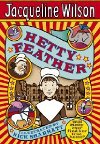Hetty Feather by Jacqueline Wilson

Doubleday,
(Ages 9+) Recommended
Hetty
Feather sometimes reads as a Victorian melodrama
with much wailing and beating of chests at the mishap and misery that
befall
Hetty. Her adored brother Jem proves to have clay feet, another brother
Saul (with
gammy leg, crutch and a severe case of influenza) is not long for this
world,
and there is some preoccupation with children heading for heaven in
white
dresses and angel wings. But of course this is quite realistic in view
of the
disease and death that blighted the Victorian era. Historical accuracy
is
occasionally questionable. Would a foundling hospital in 1876 really
have a
stationery cupboard stocked with exercise books?
Colourful characters are plentiful. Madame
Adeline the circus performer offers Hetty a glimpse of a rather more
exotic
life. Gideon, Hetty's sickly and delicate foster brother is stoutly
championed
and protected by Hetty, while her special friend Polly is almost as
good at
'picturing' as Hetty herself. All the characters are fairly
predictable, but
Wilson injects them with sufficient verve to make them lively and
appealing.
There is a wonderful history in children's literature of youngsters
defeating
ghastly adults, especially in schools; Miss Slighcarp, Miss Trunchbull
and Miss
Minchin are despised by many a reader. Now Matron Pigface Peters and
Miss
Morley can be added to this evil roll-call!
Nick Sharratt's illustrations are my only
grumble. The front cover is a delightful montage of typical Sharratt
pictures,
but the illustrations within are totally different; Sharratt uses
silhouettes,
which may reflect the Victorian story, but somehow lack the immediacy,
power and
humour of his usual style. Apart from this I predict total reader
immersion in the
rollicking plot, oodles of action and satisfying ending. Jacqueline
Wilson does
so much to make reading relevant, fun and addictive, and without doubt
she's
done it again.
Claire Larson